Johnson Controls International Bundle
How did Johnson Controls build its empire?
Journey back in time to uncover the fascinating Johnson Controls International SWOT Analysis, a global leader in smart building solutions. From its humble beginnings in 1885, the JCI company has revolutionized how we interact with our built environments. Discover how a single invention sparked a legacy of innovation and shaped the future of HVAC systems and building automation.
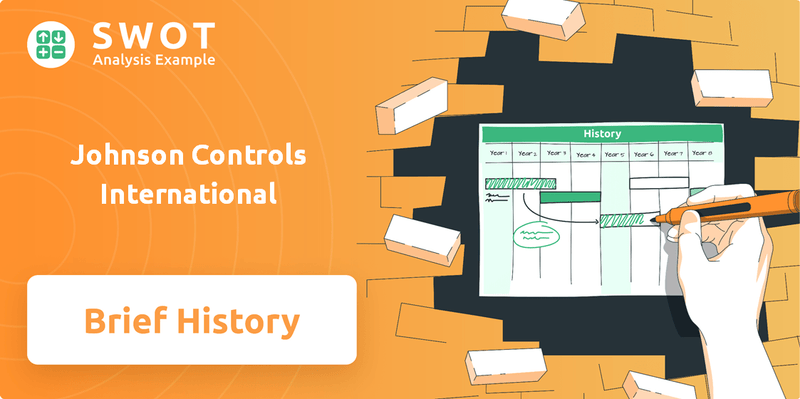
The brief history of Johnson Controls International is a testament to its adaptability and vision. Starting with Warren Johnson's pioneering work, the company has navigated numerous market shifts and strategic acquisitions, including the significant merger with Tyco International. Today, Johnson Controls' global presence and robust financial performance reflect its enduring commitment to innovation and sustainability, solidifying its position as a key player in the industry.
What is the Johnson Controls International Founding Story?
The story of the [Company Name] begins with Professor Warren S. Johnson's innovative spirit. In 1883, Johnson patented the 'electric tele-thermoscope,' a pioneering electric room thermostat, marking the inception of the building control industry.
Driven by this invention, Johnson sought manufacturing funding in Milwaukee. In 1885, he partnered with William Plankinton to establish the Johnson Electric Service Company. This marked the formal beginning of what would become a global leader in building technologies.
The company's early focus was on manufacturing, installing, and servicing automatic temperature regulation systems, capitalizing on the growing need for energy efficiency in buildings. Early installations in prominent locations quickly propelled the business forward.
The Johnson Electric Service Company was founded in 1885 by Warren S. Johnson and William Plankinton.
- The initial focus was on manufacturing and installing automatic temperature regulation systems.
- Early installations included the Milwaukee Public Library and city hall.
- Johnson served as vice president and treasurer, with Plankinton as president.
- The company's early ventures included a steam and gasoline automobile business.
The late 19th century's industrialization and the need for efficient building management were crucial in shaping the company's early focus. The company's history is a testament to innovation and strategic partnerships. For a deeper dive into how the company has grown and adapted, consider exploring the Growth Strategy of Johnson Controls International.
Johnson Controls International SWOT Analysis
- Complete SWOT Breakdown
- Fully Customizable
- Editable in Excel & Word
- Professional Formatting
- Investor-Ready Format
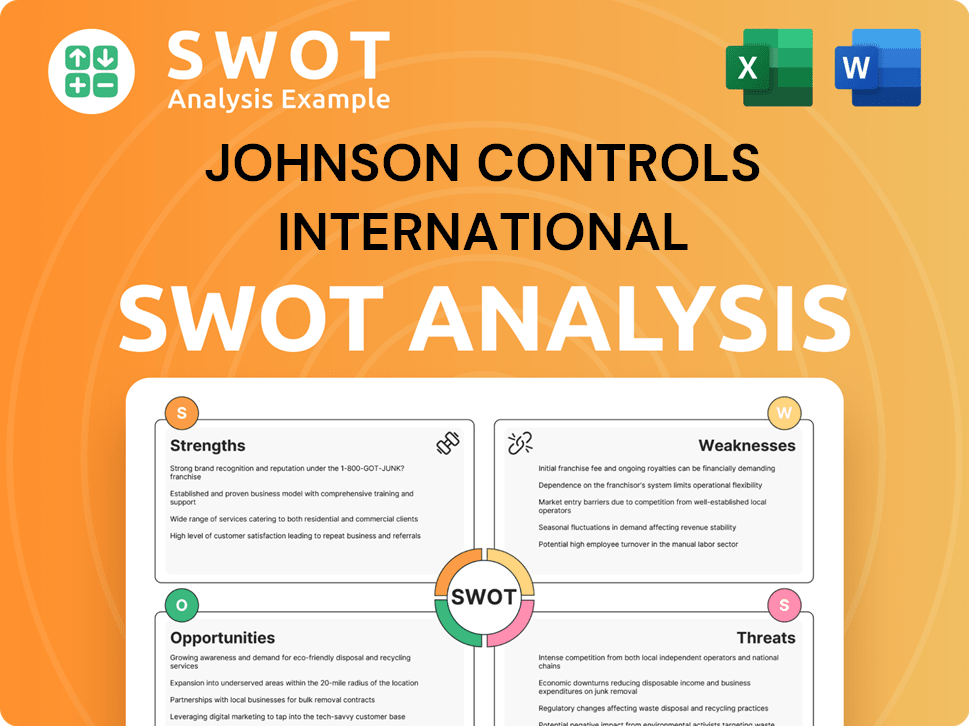
What Drove the Early Growth of Johnson Controls International?
The early years of Johnson Controls, initially known as Johnson Electric Service Company, were marked by significant growth and expansion. The company quickly developed the first automatic zone temperature control system, which was later recognized as a pioneering innovation. This period saw the company diversify its product offerings and expand its presence globally, setting the stage for its future as a diversified technology and industrial leader.
By 1895, Johnson Controls had developed the first automatic zone temperature control system. This system was installed in various locations worldwide. The company also expanded into products like steam valves and hydraulic air compressors, showcasing early diversification.
In 1902, the company changed its name to Johnson Service Company and relocated its headquarters to Milwaukee. After Warren Johnson's death in 1911, the company strategically focused on building temperature control for non-residential buildings. This strategic shift proved beneficial, leading to increased business and installations.
A key milestone was the company's public listing on the NASDAQ system in 1940. International expansion began in 1964 with the establishment of its first foreign manufacturing plant in Italy. The company's growth was further driven by key acquisitions, expanding its product lines and global footprint.
The acquisition of Penn Controls in 1968 marked Johnson Service Company's entry into the Fortune 500. In 1972, Johnson introduced the JC/80, a pioneering minicomputer system for building management. The company rebranded to Johnson Controls, Inc. in 1974, and further diversified with the acquisition of Globe-Union in 1978, becoming a leading automotive battery producer.
Johnson Controls International PESTLE Analysis
- Covers All 6 PESTLE Categories
- No Research Needed – Save Hours of Work
- Built by Experts, Trusted by Consultants
- Instant Download, Ready to Use
- 100% Editable, Fully Customizable
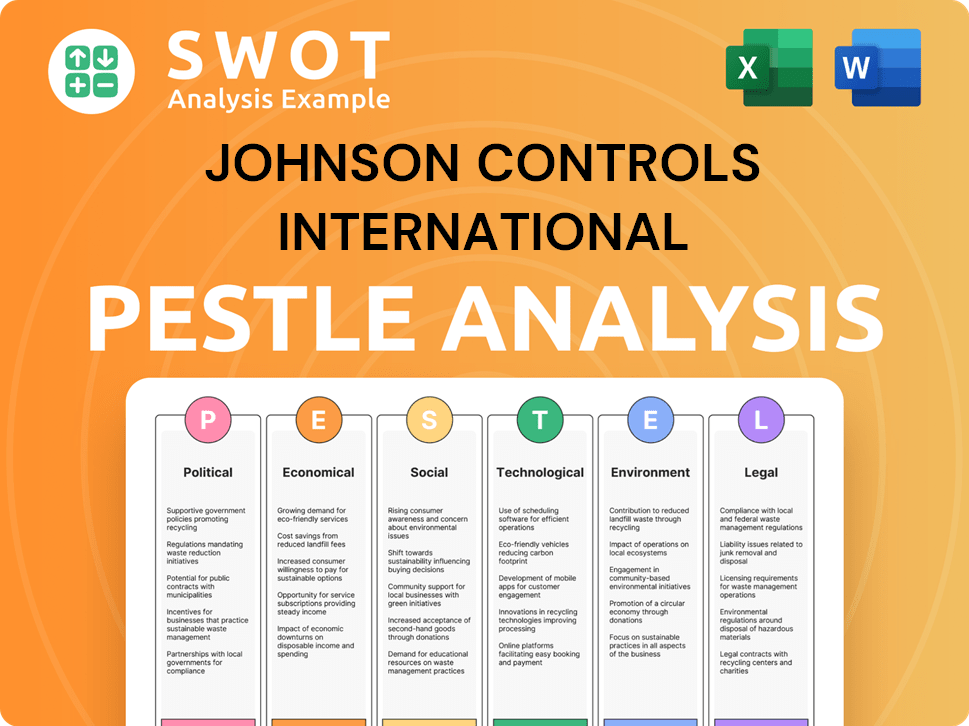
What are the key Milestones in Johnson Controls International history?
The JCI company has a rich history, marked by significant milestones that have shaped its evolution and global presence. From its founding to its current status, Johnson Controls has consistently adapted and innovated within the building technologies and automotive industries. These key milestones highlight the company's journey and strategic shifts over the years.
| Year | Milestone |
|---|---|
| 1883 | Warren Johnson patents the first electric room thermostat, marking the beginning of the building control industry. |
| 1895 | The company develops the first automatic zone temperature control system, a pivotal innovation. |
| 1990 | Introduction of the Metasys® Building Automation System, integrating various building systems. |
| 2002 | Acquisition of Varta's automotive battery division in Germany, expanding its automotive sector presence. |
| 2005 | Acquisition of York International, enhancing its global HVAC systems and refrigeration capabilities. |
| 2016 | Merger with Tyco International, creating Johnson Controls International plc and broadening its portfolio. |
| 2019 | Divestiture of the automotive seating business (Adient), focusing on core building technologies. |
| 2024 | Announced plan to sell a portfolio of its heating and ventilation units to Bosch Group. |
Innovations at Johnson Controls, particularly in HVAC systems and building automation, have been central to its growth. The company has consistently invested in research and development, leading to numerous patents and industry-leading solutions. These innovations have improved energy efficiency and building management.
Warren Johnson's 1883 patent for the first electric room thermostat revolutionized temperature control. This invention laid the groundwork for the company's early success.
Developed in 1895, this system was a significant advancement in building climate control. It was later recognized as a 'mechanical engineering landmark'.
Launched in 1990, this system integrated environmental control, energy management, lighting, and fire systems. It improved operational efficiency.
The 'OpenBlue' platform integrates AI and data-driven solutions for optimizing building performance. This platform enhances sustainability.
Through acquisitions like York International, the company expanded its HVAC and refrigeration offerings. These systems are crucial for energy efficiency.
The acquisitions of Varta and Delphi's automotive battery businesses strengthened its position. This expanded its presence in the automotive sector.
Johnson Controls history has faced several challenges, including legal and regulatory issues. These challenges have tested the company's resilience and required strategic adjustments. The company's response to these challenges has shaped its approach to business.
This 1991 Supreme Court case addressed sex discrimination related to lead exposure in the workplace. The court ruled against the company's policy.
In 2016, the company settled charges with the SEC for bribery in China, paying $14.4 million. This highlighted the need for ethical practices.
In September 2023, a ransomware attack encrypted devices and servers, leading to IT system shutdowns. This event underscored cybersecurity risks.
The divestiture of the automotive seating business (Adient) in 2019 allowed a sharper focus on core building technologies. This streamlined operations.
In fiscal 2024, a $400 million restructuring plan was initiated to achieve $500 million in annual cost savings. This improved financial performance.
In July 2024, the company announced the sale of heating and ventilation units to Bosch Group for $6.7 billion. This strategic move refines the portfolio.
Johnson Controls International Business Model Canvas
- Complete 9-Block Business Model Canvas
- Effortlessly Communicate Your Business Strategy
- Investor-Ready BMC Format
- 100% Editable and Customizable
- Clear and Structured Layout
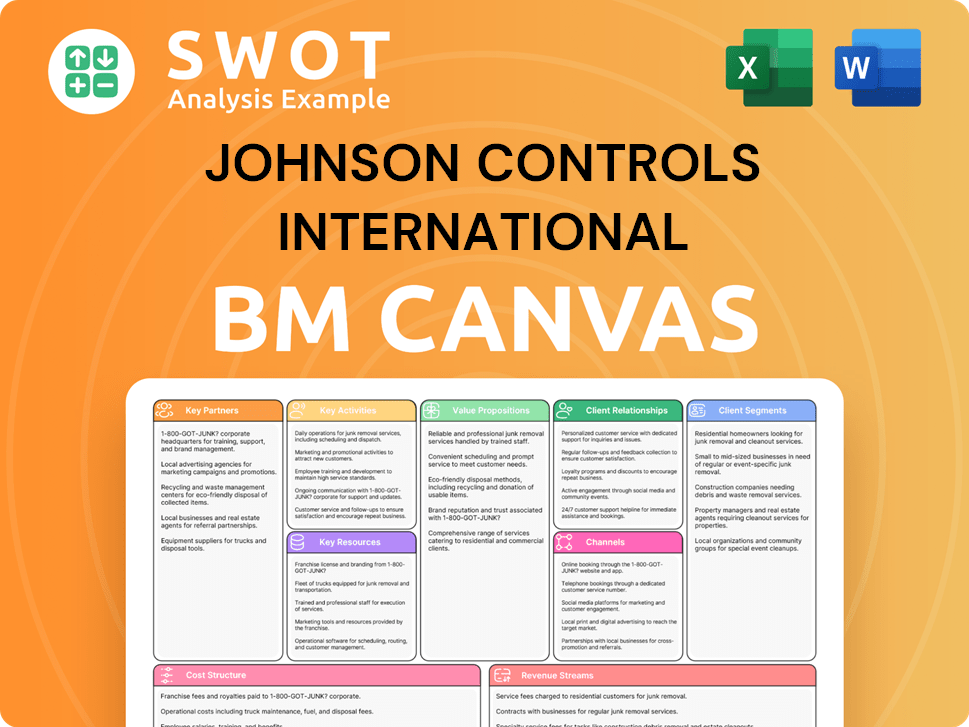
What is the Timeline of Key Events for Johnson Controls International?
The JCI company, formerly known as Johnson Controls International, has a rich history marked by innovation and strategic acquisitions, evolving from its origins in temperature control to a global leader in building technologies. The Johnson Controls history showcases a journey from pioneering the electric room thermostat in 1883 to its present-day focus on smart buildings and sustainability. Over the years, the company has expanded its portfolio through significant mergers and acquisitions, including Tyco International, shaping its global presence and influence in the HVAC systems and building automation industries.
| Year | Key Event |
|---|---|
| 1883 | Warren S. Johnson patents the 'electric tele-thermoscope,' the first electric room thermostat. |
| 1885 | Johnson Electric Service Company is incorporated in Milwaukee, Wisconsin. |
| 1895 | The company patents the first automatic zone temperature control system. |
| 1902 | Company name changes to Johnson Service Company. |
| 1940 | Johnson Service Company goes public. |
| 1968 | Acquires Penn Controls, entering the Fortune 500. |
| 1972 | Introduces the JC/80, a pioneering minicomputer system for building controls. |
| 1974 | Company changes its name to Johnson Controls, Inc. |
| 1978 | Acquires Globe-Union Inc., becoming a leader in automotive battery production. |
| 1989 | Acquires Pan Am World Services, entering facilities management. |
| 1990 | Introduces the Metasys® Building Automation System. |
| 2005 | Makes its largest acquisition, York International, expanding significantly in HVAC. |
| 2016 | Merges with Tyco International to form Johnson Controls International plc, relocating headquarters to Cork, Ireland. |
| 2019 | Divests its automotive seating business (Adient) to focus on building technologies. |
| 2023 | Experiences a ransomware attack, prompting IT system shutdowns. |
| 2024 | Announces the sale of its Residential & Light Commercial segment to Bosch Group for $6.7 billion; reports fiscal year 2024 revenue of $22.95 billion, and a building solutions backlog of $13.1 billion. |
Johnson Controls is expanding its digital offerings through its OpenBlue platform. This platform uses data and AI to optimize building performance. It is designed to create smarter, healthier, and more sustainable environments. This is expected to drive higher-margin and recurring revenue opportunities, and is a key element in the Johnson Controls strategic plan.
In fiscal year 2025, Johnson Controls projects an adjusted EPS of approximately $3.60. The company anticipates mid-single-digit organic sales growth. A free cash flow conversion of around 100% is expected. These projections reflect the company's confidence in its strategic initiatives and market position.
Johnson Controls is focused on strategic M&A in adjacent technologies and international markets. The company aims to enhance its position in key regions. An example includes the expansion at its Holme heat pump and chiller facility in Denmark, announced in October 2024, creating over 100 new jobs.
The company's commitment to sustainability, rooted in its founding vision of energy conservation, drives its innovation roadmap. Johnson Controls aims to reduce the carbon footprint of buildings. Leadership emphasizes transforming buildings to benefit people, places, and the planet, aligning with global efforts towards net-zero emissions. For more details, you can explore the Johnson Controls history.
Johnson Controls International Porter's Five Forces Analysis
- Covers All 5 Competitive Forces in Detail
- Structured for Consultants, Students, and Founders
- 100% Editable in Microsoft Word & Excel
- Instant Digital Download – Use Immediately
- Compatible with Mac & PC – Fully Unlocked
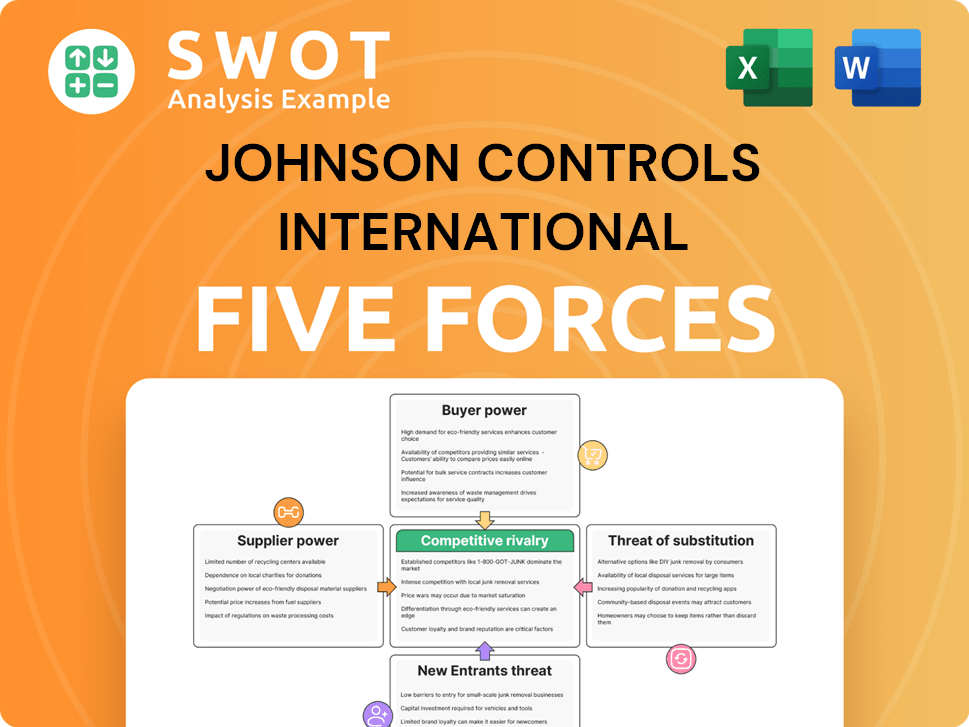
Related Blogs
- What is Competitive Landscape of Johnson Controls International Company?
- What is Growth Strategy and Future Prospects of Johnson Controls International Company?
- How Does Johnson Controls International Company Work?
- What is Sales and Marketing Strategy of Johnson Controls International Company?
- What is Brief History of Johnson Controls International Company?
- Who Owns Johnson Controls International Company?
- What is Customer Demographics and Target Market of Johnson Controls International Company?
Disclaimer
All information, articles, and product details provided on this website are for general informational and educational purposes only. We do not claim any ownership over, nor do we intend to infringe upon, any trademarks, copyrights, logos, brand names, or other intellectual property mentioned or depicted on this site. Such intellectual property remains the property of its respective owners, and any references here are made solely for identification or informational purposes, without implying any affiliation, endorsement, or partnership.
We make no representations or warranties, express or implied, regarding the accuracy, completeness, or suitability of any content or products presented. Nothing on this website should be construed as legal, tax, investment, financial, medical, or other professional advice. In addition, no part of this site—including articles or product references—constitutes a solicitation, recommendation, endorsement, advertisement, or offer to buy or sell any securities, franchises, or other financial instruments, particularly in jurisdictions where such activity would be unlawful.
All content is of a general nature and may not address the specific circumstances of any individual or entity. It is not a substitute for professional advice or services. Any actions you take based on the information provided here are strictly at your own risk. You accept full responsibility for any decisions or outcomes arising from your use of this website and agree to release us from any liability in connection with your use of, or reliance upon, the content or products found herein.